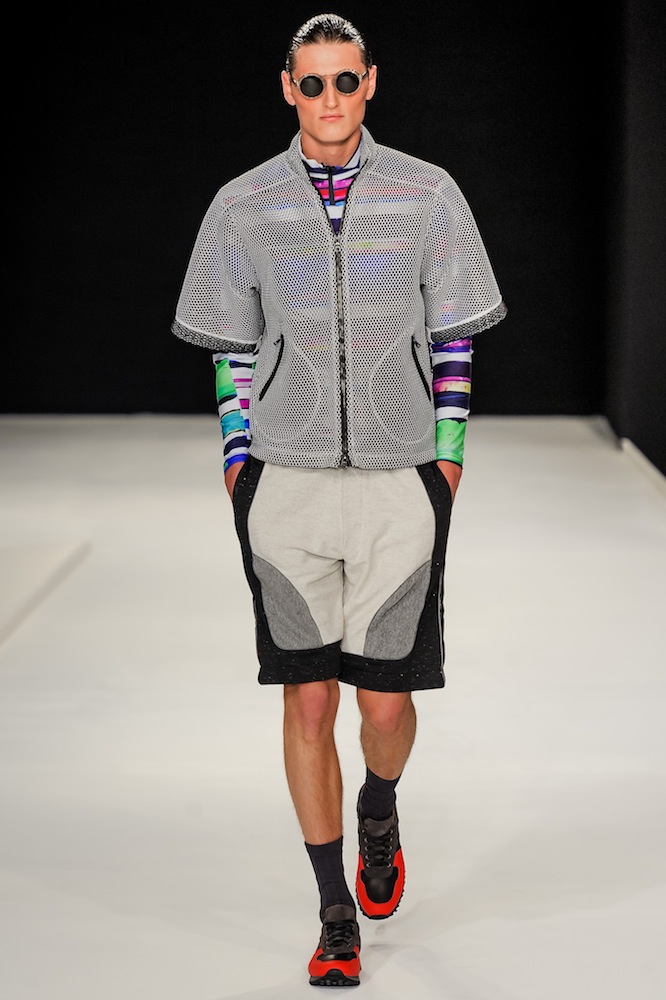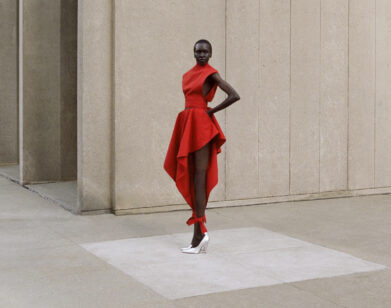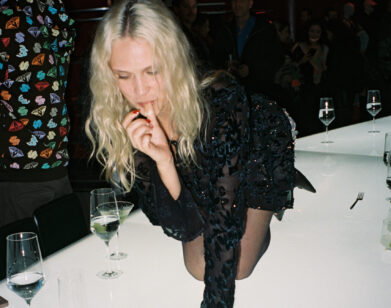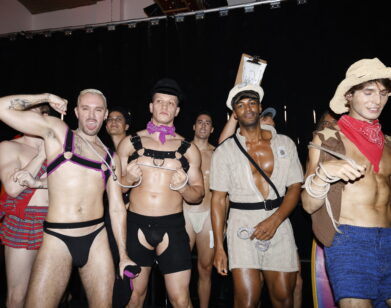Menswear Monday: James Long
There’s more to menswear than suits and ties. Every other Monday, we’re giving the fastest developing facet of fashion the attention it deserves and introducing the designers, buyers, trendsetters, and stylists you need to know.
At 32 years old, with first-place awards and generous funding from NEWGEN, Fashion East, and the British Fashion Council to his name, James Long is the unofficial poster child of the London menswear community and its efforts to support new talent. Lanvin’s Lucas Ossendrijver has gone so far as to call Long his favorite young designer. Long’s creative taste in textiles helped him climb the ranks of the city’s overcrowded menswear scene (his most recent, most covetable feat, for Spring 2014: rubberized denim).
Long has timed his rise very wisely. As his brand grows out of its humble up-and-coming-ness, he’s gaining access to new textile technologies just as they’re being developed. “Last season, I drew and designed it how I wanted it, and they had the technology to make it happen,” he reports. “When I started, I would’ve never had that sort of access.” Long is putting these privileges to good use. His last collection featured featherlight leather bonded to satin, embossed nylon, and poly-knit racing jerseys, all of which helped defend his title as a surefire LCM standout.
While the designer was gearing up for next season, we phoned him to discuss (among other things) why he finds seasons themselves to be all but totally irrelevant.
DESIGNER: Lames Long
SHOWING IN: London
TRADEMARKS: It’s really just a more high-octane approach to casual clothes. It’s almost like when you don’t want to wear a suit but you don’t want to wear sportswear—you want to wear something that still has a piece of fashion and tradition in it. I often use a lot of tailoring techniques to get that in there, but with more of a modern-day approach. I use a lot of jersey, for example, but also more classic menswear fabrics. It’s definitely not minimal. [laughs] There’s a lot going on in each piece. The silhouette goes from being casual to being more tailored—like last season, there were a lot of very sporty fabrics in the collection. So it’s always a combination.
ORIGIN STORY: I never really thought seriously about designing until after A-levels. I didn’t really know that there was a job like fashion. I’m from Northampton, not really a massive fashion scene. I didn’t really know what it was. And then one of my teachers said I should go to the Royal College of Fashion and introduced me to style bibles and Vogue and such. So I was like 19 before I really realized that it was clothes and only clothes that I wanted to do.
FUTURE COLLECTOR’S ITEMS: The first thing I ever designed was probably some shoes I did when I first came to London at the Royal College of Fashion. It was actually just one, and it was kind of horrible. [laughs] It was made out of old parts of a sports bra—it was actually quite interesting—and it had elastic parts in it. The first garment of clothing was this punky sweatshirt I designed because I wanted to wear it. I just designed it for me, I suppose. I just wore it on Saturday, actually. [laughs] I wear it all the time.
LONDON CALLING: There’s so much going on here in terms of menswear. And with the London Collections: Men turning into what it is now, it’s also brought along this community. I think a lot of people want to see you succeed here, and they’ll get behind something if they see something that they think is worth getting behind.
LESSON LEARNED: I don’t think you learn much in school. [laughs] I mean, you learn how to design a collection and how to put it on paper, but then it’s not really about clothes. You definitely have to learn that on your own. When you start making and selling clothes, you learn about that. You really have to be in touch with some sort of passion for making clothes, or else there’s no point in the selling part of it. But I always found it really fascinating, how things are put together. It’s always a challenge to do it in an interesting way, once you’ve got your silhouette and your fabrics. It sort of becomes this third wing of the garment, in a way. It can change a garment so dramatically, the way it’s constructed. It’s fascinating.
FUTURE OF MENSWEAR: I was just in Japan, at Isetan, and there are seven floors of just menswear, which paralleled any type of womenswear store, really. I think there’s no limit to it, at the moment. You think of menswear as a section of the industry, but there are so many different sections to it. And it changes so much. It was always about Milan before, and I wonder if that isn’t seeming as relevant to what the new generation is designing now. I think it goes back to your question about London. London is really good at nurturing talent. I think a lot of other cities forgot that they had to nurture their designers, and they kind of got a bit settled. Then now there isn’t really so much talent coming through. And they’ve realized that they need to be more nurturing, in tailoring or whatever it is. You need to keep bringing up the new, and London is very good at that at the moment, but who knows? It could be another capital that does it better next.
SEASONS FLEETING: I think seasons are almost irrelevant now, aren’t they? Because everyone travels, everyone moves around the world so quickly that seasons almost don’t exist. So it’s actually just designing a constant wardrobe, which is also interesting. It makes it just a constant and consistent story of design, not like, “This is winter. This is spring.” You can kind of have everything, and create your own identity.
Menswear Monday runs every other Monday. For more, click here.







